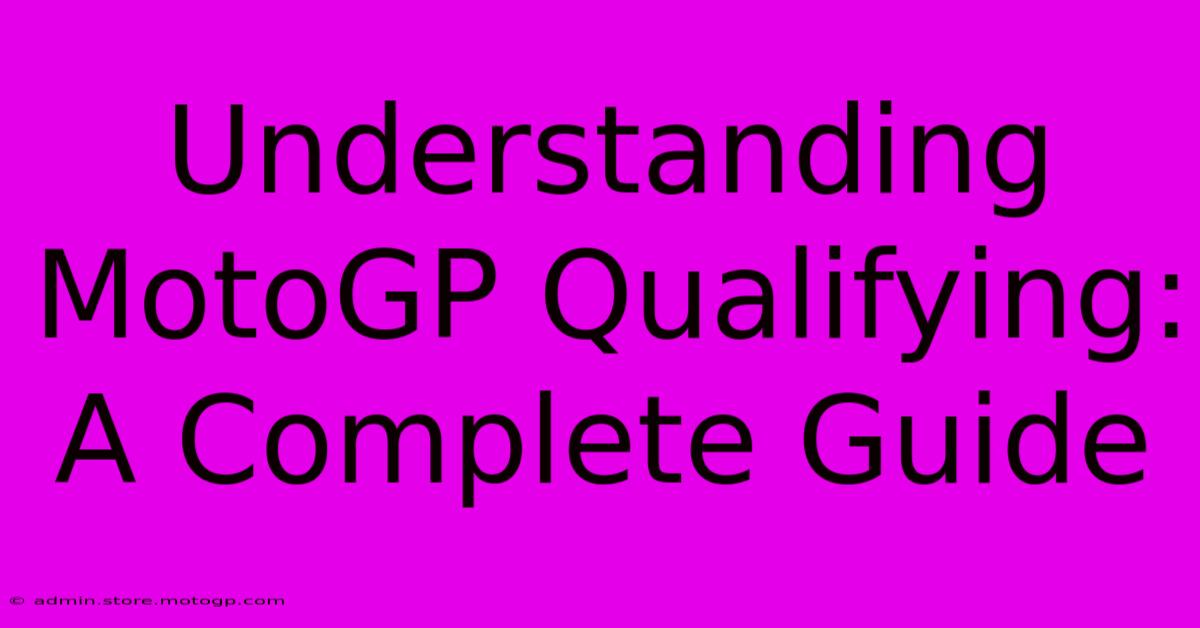Understanding MotoGP Qualifying: A Complete Guide

Table of Contents
Understanding MotoGP Qualifying: A Complete Guide
MotoGP, the pinnacle of motorcycle racing, is known for its breathtaking speeds and intense competition. But before the lights go out on race day, the drama unfolds during qualifying. Understanding the intricacies of MotoGP qualifying is crucial for any fan wanting to fully appreciate the races. This comprehensive guide will break down the process, explaining the different sessions and how riders secure their starting positions.
The Qualifying Format: A Breakdown
MotoGP qualifying is a multi-stage process designed to separate the fastest riders from the pack. The current format involves three sessions:
FP1 & FP2 (Free Practice):
These two sessions, held on Friday and Saturday, are crucial for teams to test different setups, gather data, and get a feel for the track. While they don't directly determine starting positions, the combined times from FP1 and FP2 determine who progresses to Q2. This is vital for establishing baseline performance and identifying areas for improvement before the crucial qualifying sessions. Data analysis is key here; teams pore over telemetry and rider feedback to optimize bike setup.
Q1 (Qualifying 1):
This session is for the riders who didn't finish within the top 10 combined times from the Free Practice sessions (FP1 and FP2). Only the top two riders from Q1 progress to Q2, leaving the rest to start the race from positions 13-20 (or 13-24 depending on the number of entries). Q1 is a high-pressure environment where riders push to the absolute limit to secure a place in the final qualifying shootout.
Q2 (Qualifying 2):
The top 10 riders from the combined Free Practice sessions automatically qualify for Q2. This is the ultimate showdown, where the top 10 grid positions are decided. Q2 is characterized by extreme precision and strategic tire management. Riders must balance setting a fast lap with conserving their tires for the race. The rider with the fastest lap time in Q2 secures pole position.
Understanding the Importance of Qualifying
The starting grid position is incredibly important in MotoGP. A good starting position significantly impacts the race outcome. Starting at the front provides several advantages:
- Clean Air: Leading riders benefit from clean air, which allows for higher speeds and better tire management.
- Better Race Lines: Riders can choose the optimum racing line, leading to faster lap times.
- Reduced Risk of Collisions: Starting at the front significantly reduces the risk of being involved in early-race incidents.
- Psychological Advantage: Securing a good starting position provides a significant psychological advantage both for the rider and the team.
Factors Affecting Qualifying Performance
Several factors influence a rider's qualifying performance:
- Track Conditions: Temperature, grip levels, and weather conditions can dramatically affect lap times.
- Bike Setup: A finely tuned bike optimized for qualifying laps is crucial for achieving fast lap times.
- Tire Choice: Choosing the right tires for qualifying is essential as tire wear and grip are critical factors.
- Rider Skill and Fitness: MotoGP requires exceptional riding skill, precision, and physical fitness for consistent performance.
Beyond the Numbers: The Strategy Game
Qualifying in MotoGP isn't just about individual lap times; it's a strategic game. Teams meticulously plan their qualifying strategy, considering tire management, weather forecasts, and even the performance of their rivals. Slipstreaming plays a crucial role, where riders use the slipstream of another bike to gain speed.
Conclusion
MotoGP qualifying is a captivating spectacle that showcases the precision, skill, and intense competition of the sport. Understanding the format, the importance of grid position, and the various factors influencing performance will enhance your appreciation of the races and allow you to analyze the strategies employed by riders and their teams. So next time you watch a MotoGP race, remember to appreciate the drama and intense battle that precedes the race itself – the quest for the perfect qualifying lap.

Thank you for visiting our website wich cover about Understanding MotoGP Qualifying: A Complete Guide. We hope the information provided has been useful to you. Feel free to contact us if you have any questions or need further assistance. See you next time and dont miss to bookmark.
Featured Posts
-
Yamahas Moto Gp Comeback Kid
Feb 20, 2025
-
The Ultimate Guide To Moto2 Specs
Feb 20, 2025
-
Experience F1 Like A Pro Parking Pass Included
Feb 20, 2025
-
Get Inspired Austin Gp Sprint Race Dreams
Feb 20, 2025
-
Get Started With Circuit Racing Your First Steps
Feb 20, 2025
